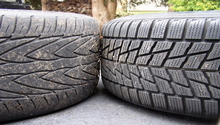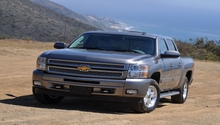Chevrolet Silverado: Which Axle Ratio Do I Have?
It is easy to check what gear ratio you have in your truck. Once you know, you can understand why it gets better fuel mileage or has better pulling power.
This article applies to the Chevrolet Silverado GMT800, GMT900, and K2XX (1999-Present).
Axle ratio refers to how many times the driveshaft turns to make the wheels turn one revolution. If you think of it in extremes, a 2.00 axle ratio means that the driveshaft turns two times for every one revolution of the wheels. If you have a 8.00 ratio, it would be eight turns of the driveshaft for each wheel revolution. A lower axle ratio (numerically higher) will send more power to the ground with the wheels turning far less than the engine. Newer cars use a high axle ratio (numerically lower) to get better fuel economy. The higher ratio is assisted by more gears being available in the transmission to get the vehicle moving and feeling like the engine is livelier.
If your truck is a four wheel drive, then both the front and rear axle have gear sets. Both sets have to match exactly in this case since they work together. If they are mismatched, the axles work against each other, but not without serious problems. Your transfer case will be stressed and that creates very bad problems in it. Those are problems you just don't need.
If you use your truck to pull heavy trailers or haul big loads, then lower gears will allow it to handle easier. If on the other hand fuel mileage is your concern, then lower gears could be better. Your axle ratio, transmission ratios, and even tire diameter all factor in, so be sure to look at the big picture.
Component Breakdown
Axle Ratio
The axle ratio is derived from dividing the number of teeth on the ring gear by the number of teeth on the pinion gear. For a 3.73 ratio, there may be 41 teeth on the ring gear and 11 on the pinion for 3.72.
The axle gears are a part of the differential, and are located behind the inspection cover on your axle. They run in gear lube, which is some nasty stuff. Get some in your hair and the attention will definitely be on you.
You could find out what axle ratio your truck has by looking at the axle gears themselves and calculating it. But fortunately, Chevrolet has made it much easier and cleaner to find out.

Figure 1. Common axle gear set illustration. 
Figure 2. Example of an axle differential inspection cover.
Finding Your Axle Ratio
Vehicle Codes Method
General Motors was good enough to put a sticker inside of your glove box with all of the production codes for the parts that were used to build your truck. Within these codes is one for the axle ratio. In this example (Figure 3), GT4 is the axle ratio code. Looking up the GT4 code via Google, or any GM reference literature, the code shows your truck has a 3.73 gear ratio.

VIN Breakdown Method
By decoding the Vehicle Identification Number (VIN), you can also find out what axle ratio your truck has. The VIN is located in many places, including the driver's side dash near the windshield, the door jamb, the title, and most paperwork that came with your truck. You can also take your VIN to your local dealer and if customer service is there, they can decode it for you.
Now you know your truck's axle ratio and can arm yourself with knowledge.
Pro Tip
Axle gearing certainly plays a part in the performance of your truck, but it is just one part. If you couple axle ratio with transmission gearing, with tire diameter, with engine power, the entire picture gets clearer. Even a truck with a big engine that is geared to high can have a hard time pulling, as well as one with a smaller engine but lower gearing.
Common Questions
Will My Truck Get Better Fuel Mileage If I Put Different Gears In It?
There is no guarantee that replacing your 3.73 gears with 3.08 will make a difference. The factory engineers your truck, so everything works together. A 2500 series with 3.08 instead of the 4.10 it was designed with may put the engine in a RPM range where it is grossly inefficient and actually uses more fuel. Research your gear choices before pulling the trigger.
Related Discussions
- Gear Ratio for 2014 Silverado - ChevroletForum.com
- Rear Axle Ratios - ChevroletForum.com
- Changing From 3.73 to 4.10 Gears - ChevroletForum.com
- What Rear End Gear Do I Have? - ChevroletForum.com
- 3.23 vs. 3.42 vs. 3.73 Gears - ChevroletForum.com






